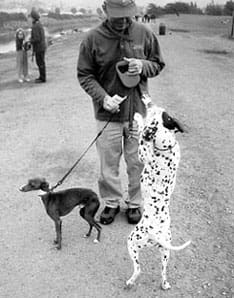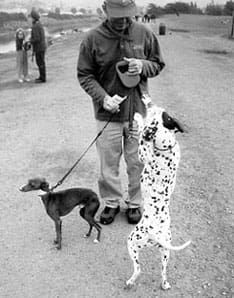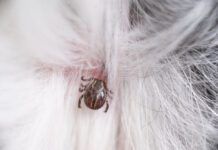He was the most loving dog in the world. He wanted nothing more than to be with me and people.”
That’s how Vicki Holt, a resident of Seattle, Washington, describes Copper, her 12-year-old Chesapeake Bay Retriever. Unfortunately, even wonderful dogs become afflicted with health conditions requiring treatment. And so is the case of this copper-colored retriever who lived to fetch.

Holt adopted Copper from an animal shelter in Seattle about 10 1/2 years ago. “I thought I wanted a chocolate Lab,” she says, but she was immediately taken with Copper, who was about one and a half years old and had recently been released to the shelter by a drug enforcement agency. He had been chosen by the agency to train as drug detection dog, but he wasn’t cut out for life on the force. Says Holt, “Copper was so fixated on the balls they used to train with that he flunked!”
Holt adored Copper, and so did just about everyone who met him. “He was protective, but not aggressive with people or dogs. He was just a mellow, sweet guy. Everybody loved him,” she says.
Copper was a healthy, active dog. “His great love in life was fetching, chasing balls,” says Holt. “He was very active. When he could get near water, that was his second love in life. He was exceptionally healthy.”
Overdoing it did it
Copper was a picture of good health – other than an occasional ingestion of something he shouldn’t have, like rotten salmon – until three years ago when Holt left Copper at her mother’s home while on holiday. Holt’s mother lived in a rural area on the Olympic Peninsula; the house was located on a steep hill. To keep the large retriever busy, Holt’s nephew batted a tennis ball down the hill, so Copper would run up and down the hill to fetch it.
Though fun, the game had ill effects. “When I got home, I found Copper was kind of lame,” says Holt. “He seemed to be hurting and limping a little bit.”
Holt contacted Copper’s veterinarian, Larry Siegler, DVM, of the Animal Healing Center in Redmond, Washington. Dr. Siegler has been practicing holistic veterinary medicine for nearly 19 years. He is certified by the International Veterinary Acupuncture Society (IVAS) in veterinary acupuncture, and is working toward certification in veterinary homeopathy and chiropractic. His practice is limited to dogs and cats.
Holt prefers a holistic approach to medicine, which is why she chose Dr. Siegler. “The significant thing for me is that the practitioner takes in the whole body, the whole system,” says Holt. “Allopathic medicine seems to treat individual symptoms.” Holt also likes the less invasive approach taken by most holistic practitioners.
Dr. Siegler’s diagnosed Copper’s problems as degenerative joint disease or arthritis, as well as hip dysplasia. Arthritis can affect one or more joints in the body. It is sometimes associated with a history of wear and tear to a joint or occurs with age. Large breeds are more commonly affected by arthritis than small breeds, and overweight dogs are more likely to experience symptoms due to extra stress on the joints. Dogs with degenerative joint disease are lame and stiff from joint pain. Cold and damp weather increases the severity of the condition.
Like arthritis, hip dysplasia is most common in large breeds. The disease is characterized by a failure of the head of the thigh bone to fit tightly into the hip socket. It can be caused by a heritable condition, or be aggravated by excessively fast growth, overfeeding, or excessive exercise. The dog may have trouble getting up from lying down or sitting, may be lame, and lose muscle tone in the rear.
Non-invasive approach
Holt thought the only treatment for hip dysplasia was surgery, though she was hesitant to even consider it because of Copper’s age. She says, “I assumed that surgery was the only thing you could do. But Dr. Siegler about that. He said, ‘Let’s try something less invasive first.’ ”
To relieve Copper’s pain and get him up and moving normally again, Dr. Siegler recommended two supplements, Adequan and methyl-sulfonyl-methane (MSM), in conjunction with acupuncture treatments.
Adequan is a trademarked product manufactured by Luitpold Pharmaceuticals, containing a glycosaminoglycan (GAG) substance, primarily chondroitin sulfate, which can stimulate the production of synovial fluid, the substance that cushions ball and socket joints and keeps them “oiled.” Unlike many other forms of GAG supplements that are administered orally, Adequan is an injectable liquid that is available by prescription only.
MSM is a naturally-occurring sulfur compound which is thought to assist the body’s growth and repair mechanisms. Its proponents say it is especially effective in relieving muscle and joint pain. It is available in a number of forms from health food stores.
However, one or both or these supplements upset Copper’s stomach. Holt switched him to a generic form of another GAG product, glucosamine, and started him on a daily dose of 1500 milligrams.
Copper received an acupuncture treatment on his first visit to Dr. Siegler, and every two weeks thereafter to begin. Acupuncture stimulates circulation, and improved circulation means improved health and less pain. When an arthritic dog feels less pain, it moves better and keeps its muscles in better shape.
Each acupuncture treatment lasted only 10 minutes or so. Dr. Siegler placed about 14 needles on specific meridian points to stimulate healing. “Copper loved the hands-on attention,” says Holt. “He never objected a bit. It’s a relatively painless treatment that can vastly improve a dog’s quality of life in his senior years and a wonderful option.”
Dr. Siegler’s treatment of dogs with arthritis and hip dysplasia varies according to the severity of the condition. While surgery (i.e., hip replacement) cannot be avoided in every case, pain can almost always be decreased. “I always will use acupuncture,” says Dr. Seigler. “Acupuncture in my hands is the deepest acting in terms of getting the body to accommodate the problem. Allopathic veterinarians obviously can’t do that. I always use some type of joint protective of agent like glucosamine. They definitely are effective. I use them myself. And then depending upon how severe the dog’s problem is, there are anti-inflammatory supplements that I might add, like MSM.”
Definite improvement
The combination of glucosamine and acupuncture worked well for Copper. Within two months, he was moving freely and well. As Copper improved, Holt reduced the frequency of his acupuncture treatments.
Copper suffered one setback about three months into treatment when Holt was out of town. She left Copper at her mother’s house again, and he might have overextended himself while “vacationing” there. “We went through the same thing again,” she says. “It set him back badly.”
To get Copper back on track, says Holt, Dr. Siegler stepped up acupuncture treatments again. “To get him back on course, we had to revert,” says Holt. “It took another couple of months to get him back where he had been before. But within two months, he was back to being quite normal again.” That meant getting up more easily, playing, bringing Holt something to throw so he could retrieve it.
Along the way, Holt was curious to know whether it was the glucosamine or acupuncture treatments that was helping Copper. She tried discontinuing the acupuncture, then the supplement. No matter which treatment she discontinued, “He got worse,” she says. “It seems the magic remedy was the combination of the two of them.”
Holt wholeheartedly recommends this simple treatment plan for dogs suffering from arthritis and hip dysplasia, especially for elderly dogs. It’s not a substitute when surgery is needed. But it can help an older dog walk gracefully into its golden years. “It can give them a much better quality of life when they are older,” says Holt.
Editor’s Note: At press time, we learned that Copper had just passed away as the result of an unrelated condition (he suffered a ruptured anal gland, and had a fatal reaction to antibiotics which were prescribed to treat a resulting infection). We offer our heartfelt condolences to Ms. Holt.
-By Virginia Parker Guidry
Virginia Parker Guidry is a freelance writer living in San Diego, California.





